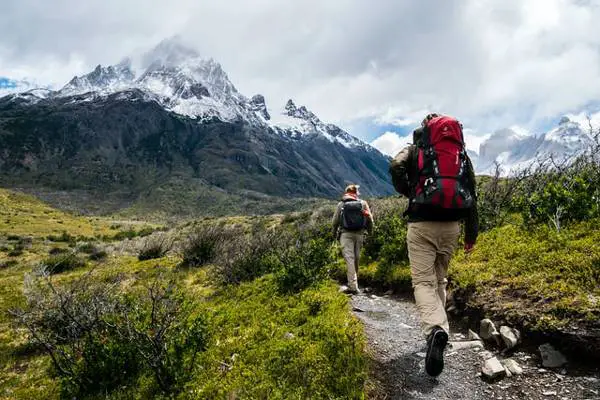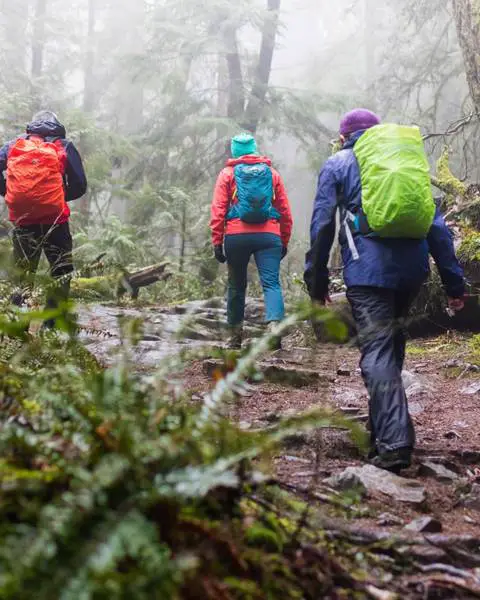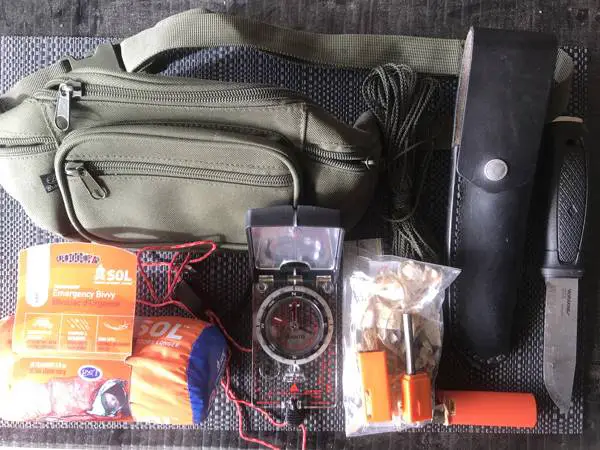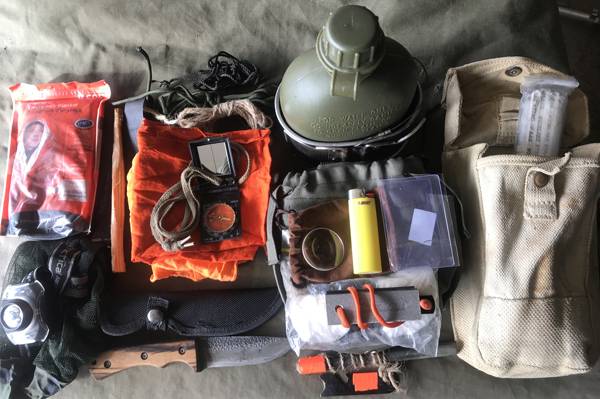How to Avoid Hypothermia In Wilderness Survival And The Importance Of Shelter. (Plus What To Carry In A Survival Kit.)
In this article we will look at how to avoid hypothermia in a wilderness survival situation and why shelter is vital for preventing it.

We will cover:
- Why shelter is important.
- The rules of three for survival.
- How your body loses heat and gains heat.
- How to spot signs and symptoms of hypothermia.
- How to prevent hypothermia in a wilderness survival situation.
- First Aid for hypothermia.
- What to carry in your bushcraft and survival kit to avoid hypothermia.
- 5 C’s and 10 C’s of Survivability.
- The primitive shelter or tarp?
- Questions to consider for wilderness survival in the cold.
- Does a space blanket work for survival?
- Stories from the cold
- Summary
This information is important for campers, hikers, fisherman in wilderness areas, hunters and for bushcraft and survival knowledge.
Why shelter is important in survival.
Shelter is a vital part for wilderness survival as it helps maintain body core temperature.
When I say the term shelter, it could mean wearing appropriate clothing, getting out of the wind behind a tree, or using a tarp to stop the rain. I do not necessarily mean build a bushcraft or primitive shelter.
You only have to go a few degrees above or below the preferred core body temperature of 98.6 degrees Fahrenheit (37 degrees Celsius) to get into serious trouble.
This will depend on conditions, stress, physical fitness and individual tolerances, but our body has a very narrow band for coping outside our favored temperature range.
Without clothing and shelter, humans prefer a tropical environment on the earth.
Shelter helps protect your core body temperature from the wind, rain, snow and cold.
Without suitable shelter you might spend a cold uncomfortable night in the wild, or worse, be in a life threatening situation and develop hypothermia.
The rule of three for survival.
These are general rules only and can obviously vary widely. But they are easy to remember and are overall guidelines to consider for a survival time.
The survival rule of threes consist of:
1. You can only last three minutes without oxygen.
2. You can only survive three hours without shelter in extreme conditions.
3. You can survive three days without water.
4. You can live three weeks without food.
Looking at the rules of three for survival, you can see that three hours in extreme conditions without shelter is a concern.
This of course will depend on the temperature, wind, rain and mindset and physical condition and can vary.
If you fall into icy cold water, you might only have minutes before your limbs are numb and you can’t operate them. Likewise in some wilderness settings in the rain and cold, you might last several hours before you start feeling the effects of hypothermia.
Not including immediate first aid needs, shelter can be more important than fire, water, food, navigation and signaling, depending on the situation. Although water and fire can also help maintain core body temperature and they work in together in a short term and long term survival setting.

How your body loses heat and gains heat.
Conduction, convection, respiration, evaporation and radiation are ways the body can gain heat or become cold. This is important to know in a real life wilderness setting. As you can be aware and alter these conditions to make the most or minimize these factors.
Let’s briefly look at each one.
Conduction – The transfer of heat from contact, like the ground.
In a practical world, we know that the cold ground saps the warmth away, so we wouldn’t sit or lie on the cold ground. We could sit on our backpack. Or put a bough bed down, comprising of spruce branches to insulate us from the cold ground.
Convection – This could be from the cold wind blowing on us, or wind chill.
We could set up a tarp shelter, or get away from the wind by hiding besides a large tree or rocks.
Respiration – We lose heat and water by breathing.
Have you stepped outside a warm tent on a cold morning and took a big breath inhaling. You can feel the cold air enter our lungs.
Evaporation – This can be from sweating.
A saying by Survivorman, Les Stroud is “You sweat you die!” In cold weather this can be very true.
If you exert yourself as an example by building a shelter, you sweat, then when you stop working and cool down the sweat can make you damp and get very cold. Layer your clothing and don’t exert yourself.
Radiation – This can be heat lost from the body. Or it could be heat gained through radiation from a fire or even the sun’s rays.
You can set your shelter up, so you can allow the fire’s natural warmth and radiation to warm you. Or snuggle up to your backpacking partner for warmth.
How to spot signs and symptoms of hypothermia.
It doesn’t have to be the Arctic to start feeling the effects of the cold. Day or night time, hypothermia can happen even in mild camping locations. Especially if you combine wind and rain.
Even in places like the desert, the temperature can drop dramatically and become cold.
Here are some signs and symptoms to look out for hypothermia:
– Shivering
– Exhaustion
– Confusion – The person might be slow and confused.
– Fumbling hands (loss of fine motor skills)
– Memory loss
– Slurred speech – The person might even appear drunk.
– Drowsiness
– Numbness or tingling
The body might experience when close to shutting down:
– A sudden hot or content feeling (This is your body giving a last ditch effort to make it
comfortable for you while it shuts down.)
– A desire to take your clothes off (Is related to your body using all its energy.)
A good way to test for how cold you are and getting into a potential dangerous situation, is to touch your pinky and thumb together a few times.
This is because in order to do this you have to use fine motor skills. This is very important because if you are unable to do this then you possibly could be unable to light a match, or open the zipper of your backpack and get a jacket out.
Try and use a Bic lighter, or matches or collect fine kindling for your fire with your hands numb. A small ferro rod might be almost impossible to get decent sparks from, especially in a cold state when you are fumbling and confused.
If you are in a hiking group, be aware of the beginning signs of hypothermia in your group. Obviously in cold, wind or rain you should be vigilant.
Be aware that the signs and symptoms can vary widely between people and person.
How to prevent hypothermia in a wilderness survival situation.
Awareness and prevention is key, here is a list of things we can do:
Avoid getting wet. Remove yourself from the situation, get to a safe dry and warm place. If this is not possible you may need to shelter with a rain jacket, poncho or tarp out of the rain. Or find shelter like under a tree.
Get out of the cold wind.
Wear appropriate layers of clothing and keep your vital organs warm. Have layers of clothing that you can remove or add as it gets colder.
Get out of wet clothing. However, if you have nothing to change into and there are harsh
winds, then you may have to make the call to keep it on. This will depend on the type of material of the clothing you have on. Such as some clothing although damp, can stop the wind from biting.
Cotton clothing can kill. Cotton is great for hot weather clothing, as it holds moisture to help cool you down. But for cold environments, cotton clothing should be avoided. Cotton when wet, zaps the heat from your body quickly. Therefore if possible you need to remove any cotton clothing if it’s damp.
Keep extremities warm. Head, neck, hands and feet warm with hat / beanies, gloves, socks, shemagh, etc.
Utilize items like hand warmers, fire and the body warmth from other people.
Keep good fitness levels.
Be aware, be vigilant. Keep a positive mindset, but be prepared for emergencies.
Don’t smoke or drink alcohol as this can affect your body’s warmth.
For backpackers and campers. – Before getting into your sleeping bed, have a warm hearty meal, do some light body squats to raise your body temperature (Don’t sweat or exert yourself. Star jumps or jogging lightly on the spot can work.), change into dry clothes.
The body loses around a fair bit of heat from conduction, so get off the ground or snow. Instead place a backpack, dry bag, tarp, blankets, dry leaves, logs, spruce boughs, or anything you can find underneath you to insulate you from the ground.
You can heat up a metal single walled water bottle for warmth in the fire. Wrap it in a sock or shemagh.
For a more bushcraft and survival option, heat up rocks. (Be careful they are not from a river bed, otherwise they can explode if put into the fire.)
I have heard stories of people lost in the woods and they started to get cold, so they done exercise like jogging on the spot or dancing. (Stay in the one spot, don’t run around the forest at night time.) Another one is to touch a tree with you hand and walk fast around it multiple times to elevate your body temperature.
Carry multiple ways to light a campfire. Also carry tinder like cotton balls with petroleum jelly and some fatwood. (There are plenty of commercial fire starters as well, but you do not wanting to be wandering around the wilderness trying to collect dry natural tinder when wet and cold.)
Make sure to drink water, surprisingly dehydration is common with hypothermia as people are so cold they forget to drink. Try to have warm drinks.
Avoid sweat, for example if you have an emergency survival space blanket do not put it against your bare skin, as it will create sweat that will cool you down.
Insulate, if the person is in a sleeping bag, stuff it with spare clothes so the heat can’t escape and keep the volume of cold open air down.
Change to dry socks.
Wear appropriate footwear.
Have an emergency survival kit with you and know how items and tools work.
Double check the weather forecast before you head out.
Tell your partner exactly where you are going and when you will return. Better yet, write it down with grid coordination’s and a map for emergencies.
First Aid for hypothermia.
This is not meant to be medical advice, but some fundamentals on the well-known acronym for first aid to be aware of, known as – D.R.S.A.B.C. (There are multiple variations on this acronym such as, DRABC.)
For cold weather we will use parts of DRSABC, which stands for:
D – Danger. Get the patient out of the cold, find or make shelter.
R – Response. Can the patient remember their name? Is there speech slurred and they can move their hands.
S – Send for help or alert someone. (911 or the country emergency number.)
A – Airways. Check.
B – Breathing. Check and keep the patient calm and collected.
C – Circulation. Check.
If no other first aid immediate danger, the goal of treating hypothermia is to warm the person. Although keep in mind warming the person too fast can result in the body going into shock.
Get the patient out of wet clothes if applicable and into dry clothes.
Keep the person out of the wind and start warming the person up. A lot of the prevention methods, such as using a fire for warmth, shelter, blankets or body heat can be used.
Always seek appropriate medical advice and get help as well as soon as possible.
Take a first aid course or refresher course. There are some great wilderness first aid courses available as well.
What to carry in your bushcraft and survival kit to avoid hypothermia and help with a shelter.

Your waist bag, backpack / day pack or haversack should contain what it takes to survive for 72 hours.
Here is a list of some options you might consider in your survival kit:
Appropriate clothing*
Fire lighting tools (Ideally lighter, ferro rod, matches and dry tinder.)
Cutting tool
Cordage (Help set up the tarp.)
Water bottle (Ideally metal single walled water bottle or metal cup.)
Headlamp or flashlight.
First Aid kit
Navigational instruments (GPS and map and compass.)
Signaling tools (Emergency Whistle, signaling mirror)
Tarp
Cell phone charger
Here is some more information on the items for the survival kit.
*Have appropriate clothing for the conditions, including rain jacket or poncho. (Allowing for the weather changing to worst case of rain, high wind and storms.) Clothing is its own micro-environment and the first line of defense against the cold, wind and rain.
(It is easier putting a rain jacket on, then starting a fire and setting up a debris hut.)
Have a tarp or heavy duty survival blanket like: Grabber All Weather Space Blanket, Pathfinder Survival Blanket, Arcturus All Weather Outdoor Survival Blanket, or S.O.L. Survive Outdoors Longer Emergency Shelter Kit.
Having a hank of paracord and 4 x tent stakes can save time when setting up a tarp.
Have a couple of different fire lighting tools with you. (In case you lose one or it doesn’t work well in the environment. Understand the limitations of each tool.)
Have pre – prepared tinder or kindling so you can get a fire going quickly. A dry bag or waterproof snap-lock bag with fatwood or cotton balls with petroleum jelly are good tinder’s and fire starters. There are plenty of commercial fire starters as well, but you do not wanting to be wandering around the wilderness trying to collect dry tinder when wet and cold.
A hatchet, axe, tomahawk or saw is invaluable for cutting fire wood in cold areas.
Be prepared to self-rescue if no help is available. Have a GPS, (Batteries are susceptible to the cold.) map and compass and know how to use a map and compass. When you start feeling the effects of the cold, even turning on a GPS or getting a map out might be hard to do.
A tea candle is also a good idea to carry in your survival kit as it can help light damp kindling. Also surprisingly it generates a bit of heat for such a small item.
For ultralight hikers, you can get some very lightweight tarps (although can be expensive) that also fold up small and take up minimal space.
Ideally have some survival items in your pockets, in case you get separated from your backpack.

Every fire lighting tool has its positives and negatives.
(I love ferro rods, but also understand they have their limits. A flame source like a lighter and matches also should also be carried in a wilderness survival kit. I normally carry 2 x Bic lighters and a large ferro rod.)
For information on knowing what is a flint and steel and what is a ferrocerium rod, click on – Difference Between Flint and Steel and Ferrocerium Rod.
5 C’s and 10 C’s of Survivability.
Another way to look at what to include in your bushcraft and survival kit to help stay warm, is to look at the 5 C’s and 10 C’s of Survivability. This list is created by David Canterbury of the Pathfinder School.
The first 5 C’s are very important tools that are hard to create in the wild, or take a long time to make.
- Cutting tool. (Like a knife or hatchet, etc.)
- Combustion device. (Lighter, matches, ferro rod, etc.)
- Cover. (Appropriate clothing, tarp, etc.)
- Container. (Water bottle, metal mug.)
- Cordage. (Paracord, micro cord.)
- Compass. (Navigational gear.)
- Candling device. (Light, head lamp, flashlight.)
- Cotton material. (Cotton bandana, shemagh.)
- Cargo tape. (Duct tape, Gorilla tape.)
- Canvas needle.
The 5 C’s and 10 C’s of Survivability is a good way of going through your survival kit list and making sure your kit has some basic, but important tools in it.
The combustion device, cover elements and cordage (for helping put up the tarp) is important for cold environments.
You could add an extra 11th C, which could be, “Communication devices” to the list as well like: Satellite phone, Personal Locator Beacons (PLBs), cell phone and charger, etc.
The primitive shelter or tarp?
How long does it take to build a bushcraft shelter? That is assuming you have resources about to build it from.
Can you find material in the dark to help build it?
Can you build a debris shelter with a sprained ankle in the wilderness with you getting wet and early signs of hypothermia setting in?
I know some bushcraft and survival books and YouTubers will tell you it is easy to build a bushcraft shelter, but it takes time, energy and resources for the inexperienced. (And experienced.)
It can take over three hours to build a debris hut and it may not even be remotely waterproof or wind proof.
It is advisable to take a tarp or large heavy duty garbage bag liner. (Remember some paracord for the ridgeline and tent stakes to help put up the tarp quickly and easily.)
If you have time, energy and health, a hybrid tarp / debris shelter can work very well for a bush shelter if you know you are going to be stuck overnight or lost.
Don’t build it too large otherwise you lose too much body heat in a large shelter. (You also use too much energy and time building a large shelter.)
Use the tarp for the low roof. Utilize bark, branches, large trees and bushes, fallen logs for one part side of the shelter or sides. Use dry grasses, dry leaves, branches, pine needles to insulate you from the ground.
Unless you are a survival expert like Mors Kochanski, Ray Mears, Cody Lundin or Matt Graham to name a few, carry a suitable tarp shelter and practice putting it up.
Questions to consider for wilderness survival in the cold.
Here are some questions and food for thought about hypothermia and preventing it in a wilderness setting.
Have you got appropriate clothing if the weather changes for the worse?
What bushcraft and survival items do you carry in your survival kit?
Can you light a fire with matches in strong winds?
Do you know the limitations of a cheap space blanket?
How quickly can you set up a tarp to stop the rain or wind?
Can you operate a Bic lighter when your hands are numb?
Do you know how to dry out a Bic lighter when it gets wet?
What would happen if your cell phone had no service, or went flat and you were lost?
Can you light sub-par tinder (damp) with a small ferrocerium rod in the cold and rain? Have you practiced with it?
Do you carry spare warm clothes in a dry bag?
What would happen if two or three members of your party gets hypothermia? Or you get it, is anyone else trained or even aware of the signs of hypothermia?
Does a space blanket work for a survival situation?
Yes, they are good for reflecting body heat, but the cheap ones have several limitations like:
- Small in size.
- Rip easy.
- Noisy to use.
- No attachment points like, grommets or tarp webbing loops.
- Hard to use on windy day. You have to hold them around you, which can be hard to do while hands are cold and you are shivering.
- Start sweating in them after couple of hours.
- Generally they are a one use item. (You need a master degree to fold them back up and put them back in their pouch.)
Mylar thermal space blankets can be nice and small and lightweight for hikers and back packers, but avoid the cheap ones. Select a better brand like SOL, as these are more durable.
You might carry a small space blanket and a heavy duty space blanket like the Arcturus All Weather Outdoor Survival Blanket or Pathfinder Survival Blanket, as well as a tarp.
An advantage of the Mylar space blanket is they can also be used for signaling or for collecting water as well.
Because of their small size I still carry one, but don’t think this is the only shelter you will need. Appropriate clothing, awareness, fire lighting tools and a tarp should be a priority.
Stories from the cold.
These are some true excerpts of real life.
“During an army survival exercise a friend got hypothermia. We were in the field for several days and it had been raining and cold. We should have spotted the signs earlier, initially he was acting like he was drunk. His speech was slurred and he was rambling on. It could have been a potential bad situation if we didn’t take action and help him warm up and shelter him.”
“One morning I was practicing some bushcraft and survival skills and slept under a lean to debris shelter with a long fire close to me. Overnight it dropped to minus degrees. I woke up freezing and the fire had gone out. I tried re-lighting the fire with a Bic lighter, but it wouldn’t work. (I didn’t have time to place the lighter close to my body and try and warm it up. The coals were also to damp to try and use them to get the fire going.) Luckily I had a secondary means of fire lighting and used my ferrocerium rod with cotton balls coated in petroleum jelly and some fatwood.”
“During an army exercise we operated in day temperature of around 100 degrees Fahrenheit (38 degrees Celsius) we didn’t have our back packs and had to sleep the night on the ground. At night time the temperature dropped quickly and the ground and air become very, very cold. A combination of no shelter from the cold damp air, and no protection from the ground sapping our warmth away (Conduction from the cold ground.) and it was the coldest and longest miserable night I had experienced.”
Summary
You can get hypothermia in not just extremely cold area, but mild conditions as well. Especially if you are wet and in the cold wind.
Your core body temperature is around 98.6 degrees Fahrenheit (37°c), however if the core temperature drops only two or three degrees this is when you can expose yourself to hypothermia.
Hypothermia can be fatal.
Awareness of your environment is essential. Avoiding getting yourself wet in the first place. Get out of the wind and warm up.
You should have a warm waterproof jacket, a tarp and a means of fire lighting.
Update your skills and take a first aid course.
In this article we have learnt how to identify and prevent hypothermia. Remember to get help and call emergency services as well.
Written by John Miller.
Further reading and resources:
Surviving a Wilderness Emergency. By Peter Kummerfeldt.
The Survival Medicine Handbook. By Joseph Alton, M.D. and Amy Alton A.R.N.P. (Advanced Registered Nurse Practitioner)
98.6 Degrees, The Art Of Keeping Your As Alive! By Cody Lundin
Ray Mears Essential Bushcraft. By Ray Mears
Bushcraft, Outdoor Skills and Wilderness Survival. By Mors Kochanski
Survive! Essential Skills and Tactics To Get You Out of Anywhere – Alive. By Les Stroud
